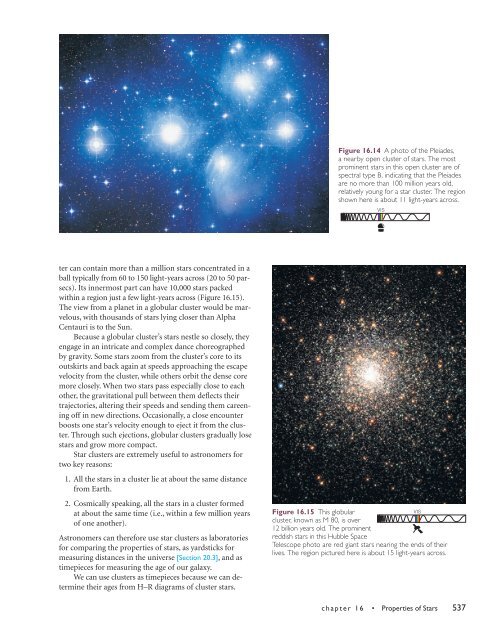Chapter 16--Properties of Stars
Chapter 16--Properties of Stars
Chapter 16--Properties of Stars
Create successful ePaper yourself
Turn your PDF publications into a flip-book with our unique Google optimized e-Paper software.
ter can contain more than a million stars concentrated in a<br />
ball typically from 60 to 150 light-years across (20 to 50 parsecs).<br />
Its innermost part can have 10,000 stars packed<br />
within a region just a few light-years across (Figure <strong>16</strong>.15).<br />
The view from a planet in a globular cluster would be marvelous,<br />
with thousands <strong>of</strong> stars lying closer than Alpha<br />
Centauri is to the Sun.<br />
Because a globular cluster’s stars nestle so closely, they<br />
engage in an intricate and complex dance choreographed<br />
by gravity. Some stars zoom from the cluster’s core to its<br />
outskirts and back again at speeds approaching the escape<br />
velocity from the cluster, while others orbit the dense core<br />
more closely. When two stars pass especially close to each<br />
other, the gravitational pull between them deflects their<br />
trajectories, altering their speeds and sending them careening<br />
<strong>of</strong>f in new directions. Occasionally, a close encounter<br />
boosts one star’s velocity enough to eject it from the cluster.<br />
Through such ejections, globular clusters gradually lose<br />
stars and grow more compact.<br />
Star clusters are extremely useful to astronomers for<br />
two key reasons:<br />
1. All the stars in a cluster lie at about the same distance<br />
from Earth.<br />
2. Cosmically speaking, all the stars in a cluster formed<br />
at about the same time (i.e., within a few million years<br />
<strong>of</strong> one another).<br />
Astronomers can therefore use star clusters as laboratories<br />
for comparing the properties <strong>of</strong> stars, as yardsticks for<br />
measuring distances in the universe [Section 20.3], and as<br />
timepieces for measuring the age <strong>of</strong> our galaxy.<br />
We can use clusters as timepieces because we can determine<br />
their ages from H–R diagrams <strong>of</strong> cluster stars.<br />
Figure <strong>16</strong>.14 A photo <strong>of</strong> the Pleiades,<br />
a nearby open cluster <strong>of</strong> stars. The most<br />
prominent stars in this open cluster are <strong>of</strong><br />
spectral type B, indicating that the Pleiades<br />
are no more than 100 million years old,<br />
relatively young for a star cluster. The region<br />
shown here is about 11 light-years across.<br />
Figure <strong>16</strong>.15 This globular<br />
VIS<br />
cluster, known as M 80, is over<br />
12 billion years old. The prominent<br />
reddish stars in this Hubble Space<br />
Telescope photo are red giant stars nearing the ends <strong>of</strong> their<br />
lives. The region pictured here is about 15 light-years across.<br />
VIS<br />
chapter <strong>16</strong> • <strong>Properties</strong> <strong>of</strong> <strong>Stars</strong> 537
















